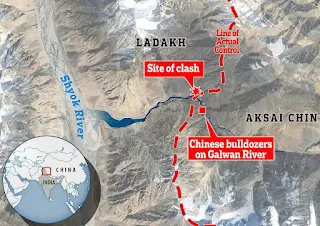 |
| China -India clash site[Daily Mail] |
The Chinese army is retreating from Galwan. But is this just a showoff like 1962?
India is wary of the experience of the 1962 war. At the beginning of that year, India and China were embroiled in a border dispute. Then the Chinese troops retreated.
But the People's Liberation Army (PLA) reached its climax, as the temperature in Galwan fell at the beginning of winter. The Sino-Indian War began. Remembering this bloody story New Delhi isn't blinking on the border.
July 15, 1962. On Sunday, the headline was "Withdrawal of Chinese forces from Galwan." This newspaper headline of almost six decades ago became viral on social media. There are also warnings related to this. Because exactly 98 days after that time in 1962, the Indo-china war began on October 20. And one of its centers was this galvanic.
According to the former military, China has adopted a policy of two steps forward, one step back at the border. Therefore, Delhi must put pressure on Beijing to return to the other side of the line of actual control.
According to military sources, the distance between the Indian and Chinese forces is maintained to avoid tension. According to them, these are small steps. However, they also say to be careful, bearing in mind the history of 1962.
What happened at that time in 1962?
At that time, the regiment of Gorkha was in the Galvan valley. On July 6, a Chinese platoon saw Gorky's troops. They went to the headquarters and gave the news. Four days later, China assembled an army of 300 in the Galwan Valley. They surrounded the Gorky regiment. The tension between the two sides has begun.
On July 15, the media reported that Chinese troops retreated 200 meters from Galwan's post. But it was only "temporary". They were coming back again. This was followed by a three-month correspondence between New Delhi and Beijing. Meanwhile, summer began to roll and winter began to come. The temperature in Galwan also started dropping rapidly. Taking this opportunity, Chinese troops launched a surprise attack on the post in Galwan on October 20 of the same year. 36 Indian soldiers were killed. The Indo-china war began. Fighting broke out in several areas along the border between India and China, including Galwan.
Almost 6 decades later, Galwan remains the epicenter of the conflict. There are some similarities with previous events. On Sunday evening, the Chinese military began to retreat from the battlefield of Galwan or from the point of patrol 14. In addition, Chinese armored vehicles lagged behind in the occupied areas north of the hot spring of Gogra and Lake Pangong. But Indian forces are keeping a watchful eye on history.
Written by codegRay

